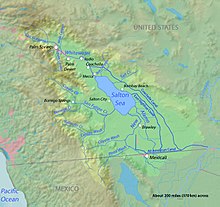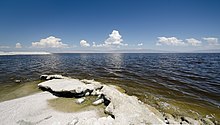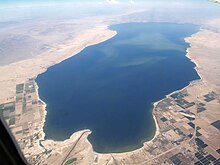Salton Sea
| Salton Sea | ||
|---|---|---|

|
||
| The Salton Sea | ||
| Geographical location | California ( USA ) | |
| Tributaries | New River , Whitewater River , Alamo River | |
| Drain | none | |
| Data | ||
| Coordinates | 33 ° 19 ′ N , 115 ° 49 ′ W | |
|
|
||
| Altitude above sea level | −71.3 m | |
| surface | 974 km² | |
| Maximum depth | 13 m | |
|
particularities |
drainless, very salty |
|
The Salton Sea ( English Salton Sea ), with an area of nearly 1,000 square kilometers, the largest lake in the state of California . The lake is located in the Colorado Desert in southern California west of the Chocolate Mountains . The border between Imperial and Riverside Counties runs through the lake . The New River , Whitewater River , Alamo River, and other small rivers flow into the Salton Sea, which itself has no drainage. Its water level sinks through evaporation. It is located in the Salton - sink (ger .: Salton sink ) about 66 meters below sea level. The Salton Sea State Recreation Area and the Sonny Bono Salton Sea National Wildlife Refuge are located on the lake . The size of the lake fluctuates due to the irregular flow of water. As a result of evaporation, the salt content of the water has increased significantly. Over-fertilization also threatens the lake's ecosystem.
history
The Salton Sea was created artificially. After the Imperial Valley Canal (Alamo Canal) no longer conducted enough water from the Colorado River into the valley due to silting in 1905 , the operating California Development Company came up with the idea of creating another overflow from the Colorado River to the canal. The unsecured connection, however, did not withstand the subsequent floods of the Colorado and the Gila Rivers and a disaster occurred. The embankment or the heaped dam broke over a length of around 800 meters. At times, all of the water in the Colorado River flowed into the Salton Depression. There a 70 km long and 30 km wide lake formed in the otherwise dry basin that belongs to the Imperial Valley . The water collected at the deepest point of the valley. It was not until 1907 that construction work on the Southern Pacific Railroad brought the floods under control and the Colorado flowed again in its old bed. The initial water level was −50 m, in 1920 the lowest level was −83 m. Since 1980 the level has been relatively stable at around -72 m and a maximum depth of 13 m.
The flooding also ensured that the town of Salton, a railroad workers' settlement that could be evacuated in time, sank. Even if the area was dry when white settlers arrived, there was often a water point here in earlier times. Today it is assumed that about 300 years ago there was a lake that was named Lake Cahuilla , but which has evaporated. The Salton Depression, which was originally part of the Gulf of California , was separated from the Gulf by delta deposits of the Colorado River 120,000 and 67,000 years ago. The lakes created by the constriction were each evaporated in an arid climate .
In the 1920s, the Salton Sea became a popular destination for the residents of Southern California. In addition, it soon became a resting place for migratory birds, and fish also made their home here, e.g. B. Mullets and tilapias . The migratory birds also include the eared grebes , 90% of the North American population with around 3,000,000 specimens use this lake. The largest breeding colony of the salmon tern is here, as well as 45% of the habitat of the endangered rattle rail .
New settlements also emerged on the shore: Salton City , Salton Sea Beach and Desert Shores on the west bank and Desert Beach, North Shore and Bombay Beach on the east bank. A little to the southeast is Niland , a railway junction on the route from Los Angeles to Yuma or Mexicali . Nearby are also geothermal activities to observe, such as Schlammgeysire east of the lake. These have their origin in the location of the Salton Depression in the area of the San Andreas Fault , the interface between the North American and Pacific continental plates. The geothermal anomaly is also used to generate energy by a geothermal power plant on the south bank of the Salton Sea.
From 1942 there was a naval aviation station on the lake. There were also secret test drops with the Boeing B-29 in preparation for the atomic bomb drop on Hiroshima in 1944/45 . Artificial targets on the lake were bombed. In 1946, the Sandia Corporation and the Atomic Energy Commission took over the test facilities from the US Navy and tested, for example, bomb sights, rockets and aerial drones. Since the lake was increasingly used for civilian purposes, the testing activities were moved to Tonopah in Nevada in 1961. In 1942, filming for the film Wake Island took place at the lake and at the naval aviation station .
Since the lake has no drainage, it is a sensitive ecosystem that is increasingly endangered. In the 1950s and 1960s, fluctuations in the water level repeatedly led to flooding in the neighboring areas, but above all the constantly increasing salinity causes problems, which at 4.4 percent is now well above the salinity of seawater and above which only perch can survive are. In addition, the high proportion of fertilizers from agriculture in the tributaries leads to increased algal blooms and increased concentrations of bacteria, which in turn endangers the bird population. Until recently, the New River was considered the most polluted river in the entire United States. In addition, there is a high selenium concentration , so that it is not uncommon for dead fish to be washed ashore and bird deaths to be observed. To counteract these developments, desalination plants are to be set up and other measures to remedy the situation. Congressman Sonny Bono and his widow Mary, as well as politician Jerry Lewis , MP in the House of Representatives from 1979 to 2013 , are particularly committed to the continued existence of the ecosystem .
Since 2016, funds have been available for the rehabilitation of the lake and its surroundings from a water project that was endowed with a budget of 7.5 billion dollars by the California voters in a referendum in 2014. In the remediation project called Salton Sea Management Plan , around 1.5 to 2.5 billion dollars are to be invested over a period of more than ten years in order to limit the development of toxic dusts on the former sea bed that has fallen dry and prevent it in the long term.
tourism
The lake still attracts around 150,000 visitors a year. Tourism is suffering as conditions deteriorate, with many of the lakeside hotels closed and abandoned. The lake's future remains uncertain as it would require large sums of money and a conversion of all of the area's agriculture to be saved.
The decay of the buildings and facilities around the lake appears in episode 6 of the second season of the documentary fiction series Future Without People ("Horror Trip", USA 2010) as an example of what will happen to people's leisure facilities after a fictional disappearance of mankind .
Web links
- Plagues & Pleasures on the Salton Sea - Documentation (English)
- Salton Sea Authority (English)
- Salton Basin Overview (English)
- Salton Sea Database Program , University of Redlands (English)
- Salton Sea Ecosystem Restoration Program , Department of Water Resources
- Salton Sea - The Californians stink . Spiegel Online, September 15, 2012
Individual evidence
- ↑ Der Spiegel: Salton Sea: The Californians Stink It , September 15, 2012
- ↑ The mirror. March 26, 2016: beach of horror
- ↑ Stephan G. Bierling, Little History of California , CH Beck, 2006, ISBN 9783406541438
- ↑ USGS 10254005 Salton Sea NR Westmorland CA . US National Water Information System.
- ↑ a b Article on the Salton Sea. on DesertUSA.com [accessed November 7, 2018]. There the depth is given as 51 ft (= 15.5 m), the level as -228 ft (= -69.5 m), the deepest point of the lake or the depression is 85 m below sea level.
- ↑ Jim Bremner: Salton Sea Test Base , Desert USA
- ^ Peggy Peattie: The New River: An environmental success story . In: sandiegouniontribune.com . ( sandiegouniontribune.com [accessed April 20, 2018]).
- ↑ KPBS: Californians Drink Up $ 7.5B Water Bond; Measure Passes Overwhelmingly November 4, 2014
- ^ California Natural Resources Agency: Salton Sea Management Plan
- ^ Benjamin A. Jones, John Fleck: Shrinking lakes, air pollution, and human health: Evidence from California's Salton Sea . In: Science of The Total Environment . tape 712 , April 10, 2020, ISSN 0048-9697 , p. 136490 , doi : 10.1016 / j.scitotenv.2019.136490 ( sciencedirect.com [accessed June 15, 2020]).
- ↑ KPBS: Salton Sea Restoration Gets $ 80.5 Million In State Budget , June 28, 2016




